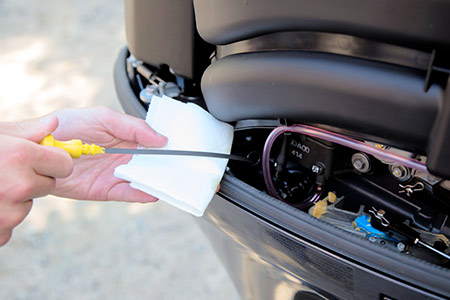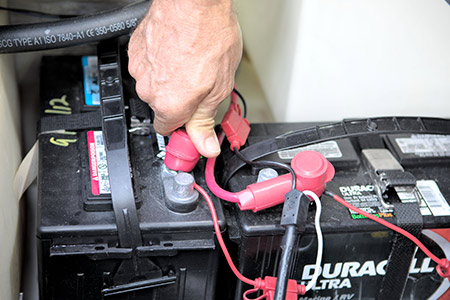Spring is here bringing with it warmer, longer days and more opportunities to get out on the water. For boaters in cooler climates, the arrival of spring means it’s time to get busy prepping their boats for the first official splash of the season.
Here are the steps you should follow to complete the thorough prep work that will ensure you are on the water enjoying your boat on the first warm day. Even if you live in warmer climates and use your boat year round, regardless of whether you keep it in the water, on a lift or a trailer, you should set aside a time once a year to do a full vessel inspection and service. It can actually save you a lot of money on unnecessary repairs in the long run.
Engine and Fuel System
Steering System and Trim and Tilt units
General Vessel Systems
Remember to always make sure to consult your outboard and boat owner's manuals for additional information about getting your boat ready for spring.
The larger the boat, the more systems to work your way through, but consider it an insurance policy for trouble-free boating in the coming year. Boaters who take good care of their vessels increase their levels of safety and ultimately protect their investment.
Back to Blue Life
Here are the steps you should follow to complete the thorough prep work that will ensure you are on the water enjoying your boat on the first warm day. Even if you live in warmer climates and use your boat year round, regardless of whether you keep it in the water, on a lift or a trailer, you should set aside a time once a year to do a full vessel inspection and service. It can actually save you a lot of money on unnecessary repairs in the long run.
Engine and Fuel System
- Remove prop/s and check the lower unit seal, then grease the prop shaft, and install a new cotter pin.
- Inspect engine zincs and replace if more than 50 percent is missing.
- Inspect battery cable connection on the engine, wire brush clean and coat with dielectric grease.
- Carefully inspect the entire fuel system for leaks, wear or weathering. This is particularly important with older boats as ethanol-blended fuels can cause a breakdown of pre-ethanol rated fuel lines.
- Look for any signs that wildlife could have damaged under cowl components, nests or chew marks on plastics are good indication that a more though inspection is needed.
- Before operating, ensure that the engine oil level is high enough to safely run the motor. Operate the vessel until the engine oil is at normal operating temperature, about 10 minutes normal cruising speed minimum. Then recheck the engine oil level to ensure that it is correct. If the oil looks cloudy or milky drain it and replace the oil filter, it likely has gotten water contamination from condensation.

Steering System and Trim and Tilt units
- Non-power assisted systems have a small fill cap on the pump body behind the steering wheel. Power assist systems are checked at the pump reservoir. Check fluid level and top off as needed. If the fluid level is low, thoroughly inspect the entire system for leaks or lose hoses.
- Grease all required areas. Zerk fittings, steering and throttle cables, etc. Don’t forget to place fresh grease on the tips of the trim rams to help prevent wear.
- Inspect the batteries. If corrosion is evident, remove and clean terminals with baking soda solution, clean cable ends and reconnect.
- Load test all batteries.
- Check the battery switches to be sure they are functional. Older models can wear out.
- Inspect battery cable connections to each switch.
- Check breakers and/or fuse panels.
- Inspect bus bars for corrosion. Wire brush clean if needed.
- Inspect grounding cables on the engine mounting bracket. Clean or replace as needed.
- Check all helm switches including trim tabs, power trim and tilt to be sure they are operational.
- Check all lights for proper function.
- Check all navigational, sonar and communications electronics to be sure they are operational. Pay specific attention to connections to be sure they are tight. Radio antenna connections are notorious for corroding. Inspect all wires and cables.

General Vessel Systems
- Inspect all thru-hull fittings from inside and outside the boat.
- Check all thru-hull shut-off valves to be sure they are working. Lubricate if necessary, replace if frozen.
- Inspect all hoses from thru-hull fittings. Be sure they are all double-clamped and that the clamps are not corroded.
- Check bilge pumps and automatic bilge pump switches.
- Check additional pumps (washdown; macerator; etc.).
- Inspect your anchor line for wear around the thimble linking it to the chain or anchor. Check the shackles to be sure the screw is not rusted tight. Remove the line from the anchor locker and inspect. Clean anchor locker while empty.
- Inspect outer hull for chips, dings, gelcoat blisters. Repair as needed.
- Inspect hardtop/t-top pipes as welds can break with age and hard vessel use.
- Inspect places where wires enter and exit the piping in case grommets are bad or missing, which can cause chafing.
- Inspect the sanitation system (head and holding tanks) where applicable to be sure they are working. Remove antifreeze if it was winterized.
- Remove antifreeze from the freshwater system where applicable, flush with clean, fresh water and refill.
- Inspect all PFDs and throwable life rings aboard for mildew. Clean if needed. For inflatable PFDs, check charging system.
- Inspect all flares, paying attention to expiration dates. If expired, purchase replacements.
- Check to see if fire extinguishers are fully charged not expired.
- Conduct a safety check of all EPIRB and PLB units to be sure they are operational and to check the battery integrity. Review the literature to see when battery replacement is recommended by the manufacturer.
- Conduct a safety check of the emergency S.O.S. system on the VHF radio if applicable.
Remember to always make sure to consult your outboard and boat owner's manuals for additional information about getting your boat ready for spring.
The larger the boat, the more systems to work your way through, but consider it an insurance policy for trouble-free boating in the coming year. Boaters who take good care of their vessels increase their levels of safety and ultimately protect their investment.
Back to Blue Life
